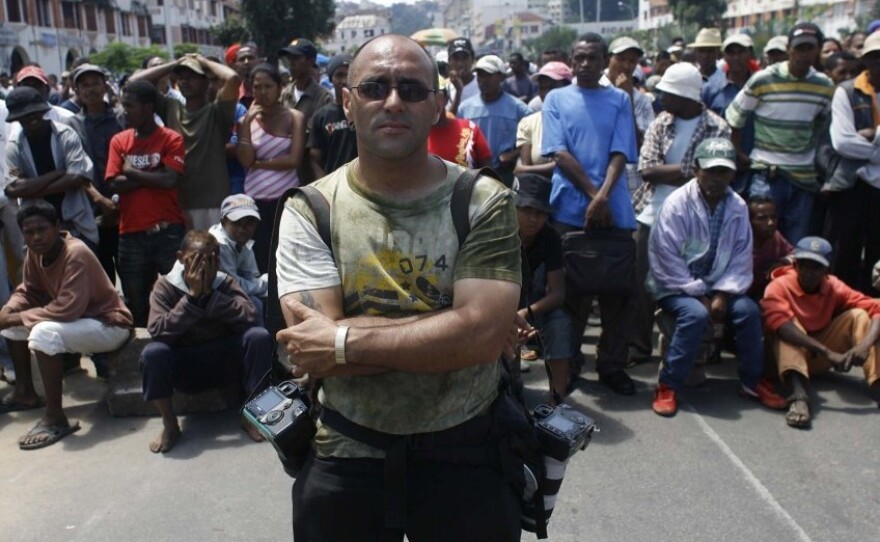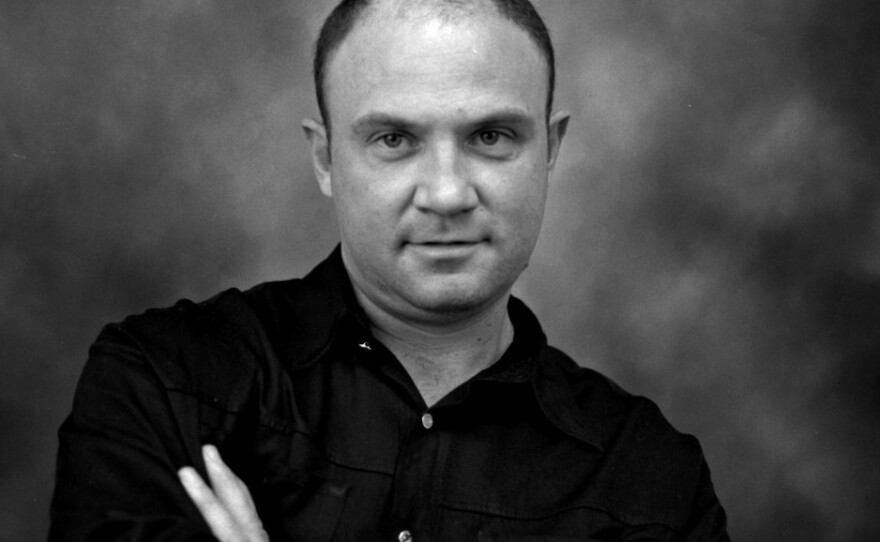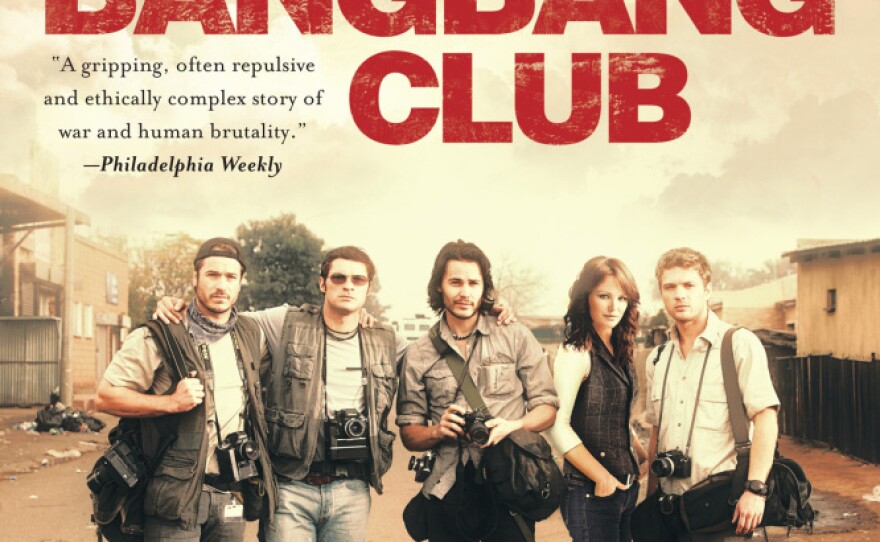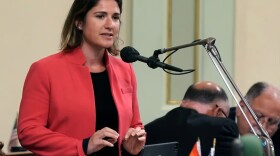
Combat photographers Tim Hetherington and Chris Hondros were killed Wednesday in Libya, and two more photographers were seriously injured. On Thursday's Fresh Air, we air an interview taped Tuesday with combat photographers Greg Marinovich and Joao Silva, both of whom have been seriously injured in the field.
Marinovich has been shot and wounded four times while covering conflicts in South Africa and Afghanistan. Silva lost both of his legs in a land mine explosion in Afghanistan last October while working as a contract photographer for The New York Times.
Silva has photographed wars in Afghanistan, Iraq, the Balkans, the Middle East and southern Africa. On the day he stepped on the mine in Afghanistan, he was embedded with a unit of the 4th Infantry Division and a New York Times reporter. Two other people and a minesweeping dog walked through the area where the mine was just before he approached.
To intercede, to change the picture is unethical. To intercede at the cost of doing your job as a journalist, I think that's a personal choice you make. And I have no issue with people on the other side of that divide.
"I was like third man in line, and I just happened to put my foot maybe a little more to the left or a little more to the right, and bam," he tells Fresh Air's Terry Gross, speaking from the Walter Reed Army Medical Center, where he is recovering. "Basically I heard the metallic sounds — bang — and got thrown over. My initial reaction was to ask the guys around me for help. The guys around me were a little bit dazed from the explosion, but they grabbed hold of me pretty quickly and dragged me away from the kill zone."
While he was being dragged away, Silva continued to snap photographs. He asked the New York Times reporter, Carlotta Gall, for a satellite phone to call his wife.
"I called my wife. I told my wife, because I had seen my legs were gone, I told my wife, 'Listen. Legs are gone. But I think I'm going to be OK. I think I'm going to live.' "
Silva's Recovery
Soon after, a medevac helicopter landed on the scene. Silva was transported first to Germany and then to Walter Reed, where he spent three weeks in the intensive care unit. In February, he took his first steps at the hospital using two prosthetic legs.
"I walk between parallel bars and use a walker when I walk longer distances," he says. "So I'm not quite balancing on my own yet, but I'm sure that will come in time."
But Silva has also suffered medical setbacks. After surgery to repair his rectal cavity and urethra, he picked up an infection and has been battling constant fatigue and pressure.
"The side of my face feels like it's the size of a melon," he says. "My eye's completely closed. There's a lot of pressure from the swelling. My white blood count has risen, so the rest of my body does feel it."
Silva faces more reconstructive surgeries to repair his urinary tract and intestinal cavity and will very likely spend several more months at Walter Reed. He hasn't picked up a camera since the incident.
"Right now, I'm focusing on my recovery. I'm either wheelchair-bound or I'm lying on my back," he says. "It's really difficult to shoot in those kind of circumstances. Bottom line, I don't feel the need. I don't want to. I have no need to. Maybe later on, closer to the end of my rehab when I'm a bit more mobile. And I might do it before everything closes up. But right now, no. I need to be more mobile."

Greg Marinovich
Marinovich has visited Silva several times in the hospital. The two photographers are good friends and two of the four members of "The Bang-Bang Club," a group of photographers who documented the final bloody years of South African apartheid before the 1994 elections.
Marinovich stopped shooting in the field after his fourth gunshot injury, which took place in Afghanistan. He had previously been shot three times in South Africa.
"After Afghanistan, I realized that this was just not productive," he tells Fresh Air's Gross. "After several weeks [after being shot for the fourth time], it just dawned on me that I don't want to do this anymore, and I don't want to be injured anymore."
In 1994, Marinovich was shot and his friend Ken Oosterbroek, another member of the Bang-Bang Club, was killed while covering a battle in South Africa.

"I thought [the bullet] had gone through me," Marinovich says. "Nobody wanted to look. I wasn't breathing properly and all sorts of things because my lung had been punctured. And there were a couple of other wounds, rather embarrassingly, in my buttocks and in my hand."
In his memoir, The Bang-Bang Club: Snapshots from a Hidden War, which he co-wrote with Silva, Marinovich describes thinking his injury in South Africa was it.
"I had paid my dues," he wrote. "I had atoned for the dozens of close calls that had always left someone else injured or dead while I emerged from the scenes of mayhem unscathed, picture in hand, having committed the crime of being the 'lucky voyeur.' "
And that sensation of guilt, Marinovich says, stayed with him while covering other war zones.
"Just seeing someone — especially a mother over a young child or a young fighter or a young civilian who's being killed — and that look they give you as you come to photograph them, while you're kind of apologizing about photographing," he says. "And people want you photographing to show what's happened, but that look of hatred — that sometimes you get from a mother — is just so disturbing."
Marinovich received the Pulitzer Prize in 1991 for Spot News Photography. He later became the Associated Press' chief photographer in the Middle East. Joao Silva has received numerous awards, including the World Press Photo award. Silva and Marinovich collaborated on the The Bang-Bang Club book, which has now been made into a film starring Ryan Phillippe and Taylor Kitsch. The film tells the stories of the four combat photographers who risked their lives to capture the atrocities committed during apartheid.
Interview Highlights
Joao Silva on photographing wars
"I have this fascination to be on the cutting edge of history [and] witness history firsthand. I've always wanted to show those that are fortunate enough not to live in a war zone the realities or certain realities of war zones, which is ultimately the point. We go out and we expose ourselves believing somehow that we have an impact on society."
Greg Marinovich on interceding
"Journalism is not a profession. It's a craft. So you don't need any training to become one. You can just do it ,which is the route that I came. And so ethics and morality and the kind of New York Times set of rules about what you can and can't do and the guidelines that you receive there wasn't a part of my background. I came to it more as a citizen and as a person than a photographer. So my thoughts about interceding and not interceding — whether it was characters or a photographer — were unformed and they became formed. And what I stuck to was really, why does it matter if you intercede to save somebody or not? And I did, on many occasions, attempt and sometimes succeed and sometimes not. It's a very strange thing. It varies from day to day with what you're thinking and what you're feeling and what the situation is. To intercede, to change the picture, is unethical. To intercede at the cost of doing your job as a journalist, I think that's a personal choice you make. And I have no issue with people on the other side of that divide."
Joao Silva on voyeurism
"Somehow the camera gives us access to the most intimate moments in peoples' lives. And you do feel out of place when you're photographing a mother cradling a dead son or whatever the case may be. Or a young Marine helping an injured friend — you do feel like you're somewhat out of place. But at the same time, you know that it's important to do it. It's what you're doing there. Otherwise, stay home and hang out with your PlayStation. ... You gotta learn to live with yourself and what you do. When you take pictures — and these are extreme situations — you are intruding. You're very fortunate to be able to record somebody else's history. I've always maintained that the true heroes are the people around me. ... I always understand that it's the history that I'm documenting — that's the whole point of being there."
Greg Marinovich on the ethics of war photography
"The other thing that photographers struggle with is the setting up of pictures. And by that, I mean, where the photographer interferes in the scene to make it a better picture — where essentially fiction and nonfiction blur — that we have real problems with. I remember a very famous New York-based photographer was at the funeral of Chris Hani, the communist leader who was assassinated by white extremists. He was directing the show to make for a better picture, and we all immediately wrote to his employer — his contract employer at the time was Time magazine — and he was pulled off the job immediately. And this other photographer we spoke about — the right-winger — he would hire a Mercedes-Benz and drive into the township and drive up and down the volatile areas until people started stoning his cars so that he could get the pictures."
Greg Marinovich on the difficulties of publishing his 1991 Pulitzer Prize-winning series of photos, which showed a man attacked with a machete and then set on fire in South Africa
"I didn't try and get it published. At the time I was freelancing, and I was shooting for the AP and also for Sigma, the photo agency. And so I had two separate cameras. One had color negative for AP and one had color slide for Sigma. And the AP put the pictures up. They put up 18 pictures in all. And newspapers complained about the graphic nature of those pictures, and many didn't publish those pictures. It wasn't that the 'burning man' wasn't widely published at all — certainly not in South America and not in America, and I can understand that; they are very disturbing pictures, and that's up for a newspaper to decide what they want to publish — but the tangential argument from that is that it's not up to us as photographers to censor that. It's not up to us to not shoot it because it's too graphic or too disturbing. It's not up to us to not edit that and put that in the take, and it's certainly not up to the distributing agency to decline to put those pictures in the take because of their graphic nature. In fact, it was the New York office of the AP that almost didn't want to move those pictures on. Because London had taken them in ... and in New York, it was difficult. They almost didn't move the picture."
Copyright 2023 Fresh Air. To see more, visit Fresh Air. 9(MDAzMjM2NDYzMDEyMzc1Njk5NjAxNzY3OQ001))












